ALEXANDRITE
Alexandrite Description
Alexandrite, with its chameleon-like qualities, is a rare variety of the mineral chrysoberyl. Its color can be a lovely green in daylight or fluorescent light, changing to brownish or purplish red in the incandescent light from a lamp or candle flame. This is a result of the complex way the mineral absorbs light.
Alexandrite’s dramatic color change is sometimes described as “emerald by day, ruby by night.” Other gems also change color in response to a light-source change, but this gem’s transformation is so striking that the phenomenon itself is often called “the alexandrite effect.”
Alexandrite’s dramatic color change is sometimes described as “emerald by day, ruby by night.” Other gems also change color in response to a light-source change, but this gem’s transformation is so striking that the phenomenon itself is often called “the alexandrite effect.”
Alexandrite is also a strongly pleochroic gem, which means it can show different colors when viewed from different directions. Typically, its three pleochroic colors are green, orange, and purple-red. However, the striking color change doesn’t arise from the gem’s pleochroism, but rather from the mineral’s unusual light-absorbing properties.
Because of its scarcity, especially in larger sizes, alexandrite is a relatively expensive member of the chrysoberyl family. It shares its status as a June birthstone with cultured pearl and moonstone.
Because of its scarcity, especially in larger sizes, alexandrite is a relatively expensive member of the chrysoberyl family. It shares its status as a June birthstone with cultured pearl and moonstone.
BIRTHSTONES & ANNIVERSARIES
Alexandrite is a birthstone for June, along with pearl and moonstone. Alexandrite is also the gem for the 55th wedding anniversary.
COLOR
Fine alexandrite is green to bluish green in daylight and red to purplish red in incandescent light.
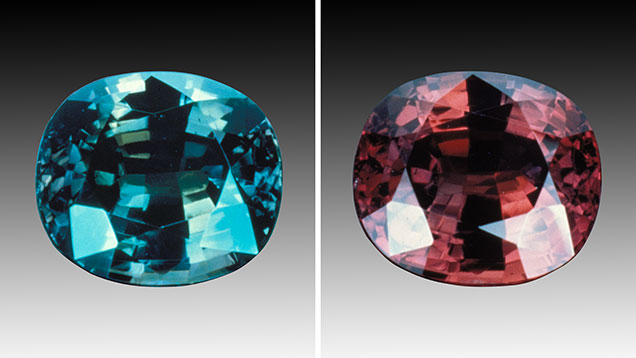 While Russia is the most famous alexandrite source, this stone from Brazil shows beautiful color change from daylight (left) to incandescent light (right). - © GIA & Tino Hammid, courtesy Mayer & Watt
While Russia is the most famous alexandrite source, this stone from Brazil shows beautiful color change from daylight (left) to incandescent light (right). - © GIA & Tino Hammid, courtesy Mayer & Watt Color
Fine alexandrite is green to bluish green in daylight and red to purplish red in incandescent light. Its color saturation is moderately strong to strong. Stones that are too light do not reach the quality of color intensity seen in fine-quality gems. Stones that are too dark lack brightness and appear almost black.
Production from Russian mines is very limited today, which means the intense, fine-colored gems they produced in quantity less than 200 years ago are much harder to come by.
Sri Lankan alexandrites are generally larger than their Russian counterparts, but their colors tend to be less desirable. The greens tend to be yellowish compared to the blue-green of the Russian stones, and the reds of Sri Lankan alexandrite are typically brownish red rather than purplish red.
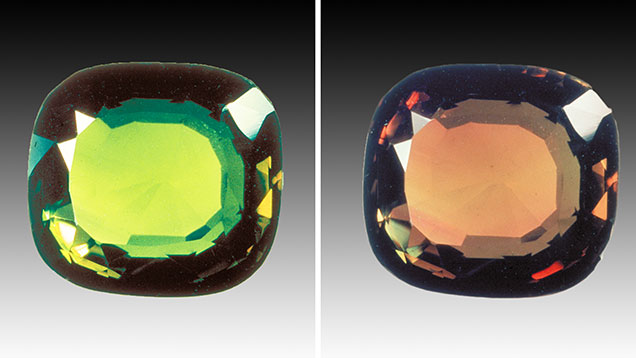
Fine alexandrite is green to bluish green in daylight and red to purplish red in incandescent light. Its color saturation is moderately strong to strong. Stones that are too light do not reach the quality of color intensity seen in fine-quality gems. Stones that are too dark lack brightness and appear almost black.
Production from Russian mines is very limited today, which means the intense, fine-colored gems they produced in quantity less than 200 years ago are much harder to come by.
Sri Lankan alexandrites are generally larger than their Russian counterparts, but their colors tend to be less desirable. The greens tend to be yellowish compared to the blue-green of the Russian stones, and the reds of Sri Lankan alexandrite are typically brownish red rather than purplish red.

This color-change alexandrite has low saturation in both its green and red colors, making it slightly brownish and less desirable. - Alan Jobbins
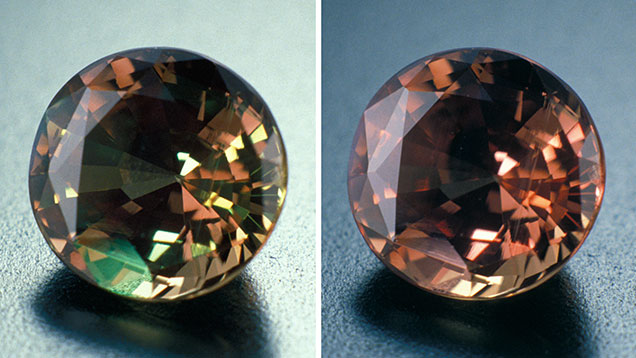
The color change displayed by this alexandrite from Sri Lanka lacks strength, and its colors are brownish.
Alexandrites from Brazil have been found in colors that rival the Russian material, but production from Brazil has decreased.
Currently, alexandrite supply is low, and fine-color material is extremely rare.
Clarity
Alexandrite tends to contain few inclusions. There’s a dramatic rise in value for clean material with good color change and strong colors.
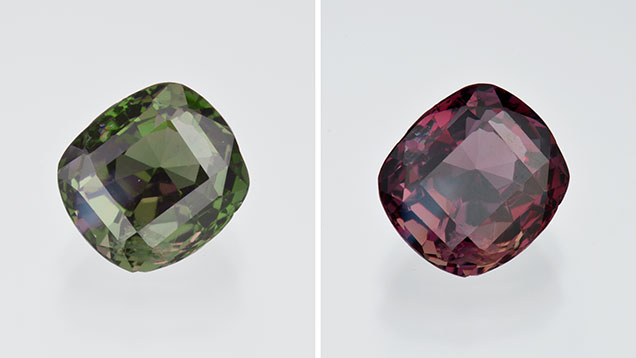
Currently, alexandrite supply is low, and fine-color material is extremely rare.
Clarity
Alexandrite tends to contain few inclusions. There’s a dramatic rise in value for clean material with good color change and strong colors.

A high clarity rating raises the value of alexandrite, especially one with nice color change like this green to red-purple example.
When certain types of long, thin inclusions are oriented parallel to each other, they can create an additional phenomenon called chatoyancy, or the cat’s-eye effect, increasing the alexandrite’s value.
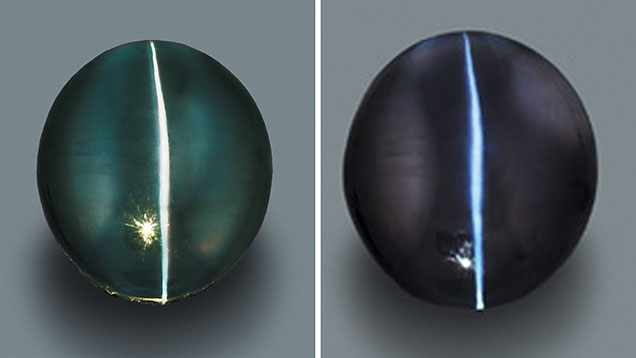

Cat’s-eye alexandrite, with beautiful chatoyancy along with color change, is extremely rare.
Cut
Alexandrites are most commonly fashioned into what are called mixed cuts, which have brilliant-cut crowns and step-cut pavilions. Brilliant cuts have kite-shaped and triangular facets, while step cuts have concentric rows of parallel facets.
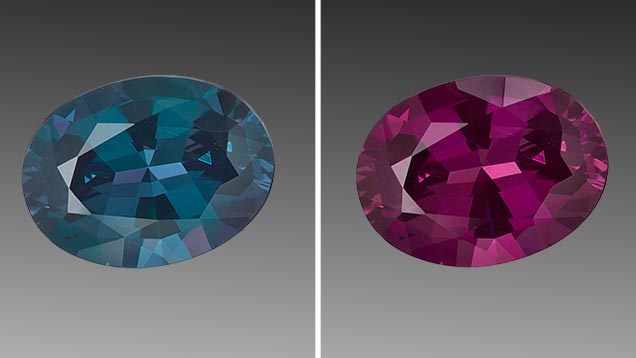
Alexandrites are most commonly fashioned into what are called mixed cuts, which have brilliant-cut crowns and step-cut pavilions. Brilliant cuts have kite-shaped and triangular facets, while step cuts have concentric rows of parallel facets.

This alexandrite has stunning color change with intense colors, and very clean clarity. It’s an oval mixed cut, which is common for alexandrite. - Courtesy Evan Caplan Fine Gemstones
Alexandrite’s pleochroism makes it a challenge for cutters. When fashioning alexandrite, cutters orient the gem to show the strongest color change through the crown. It’s crucial to position the rough so the fashioned stone shows both purplish red and green pleochroic colors face-up.
Carat Weight
Most fashioned alexandrites are small, weighing less than one carat. Larger sizes and better qualities rise in price dramatically.
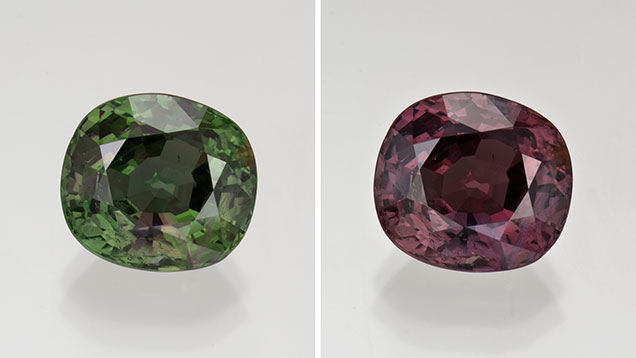
Carat Weight
Most fashioned alexandrites are small, weighing less than one carat. Larger sizes and better qualities rise in price dramatically.

This 8.82-carat cushion-shaped alexandrite shows nice color change. Its large size is rare for this stone.
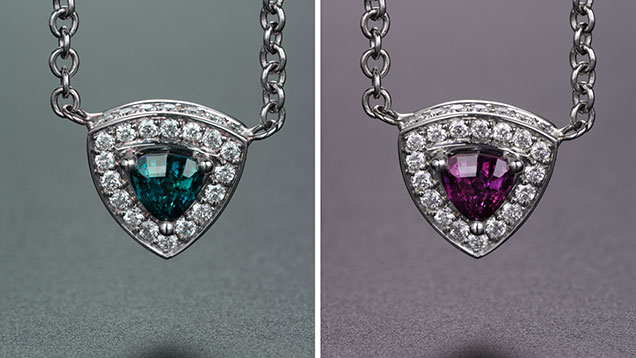
Attractive alexandrites used in jewelry are usually under a carat. This stone is a 0.65-carat triangular-shaped.


